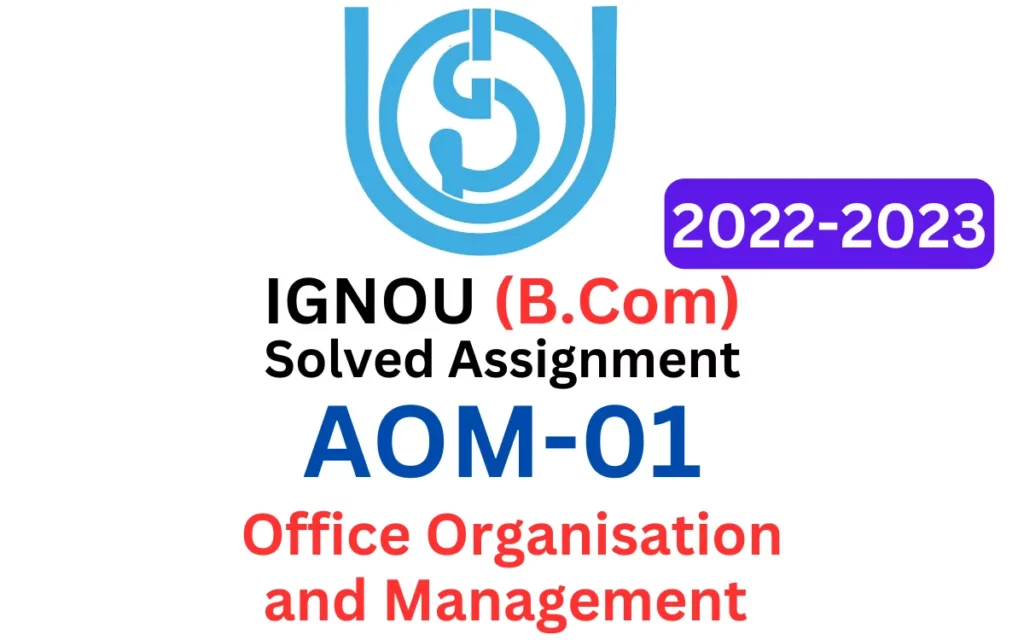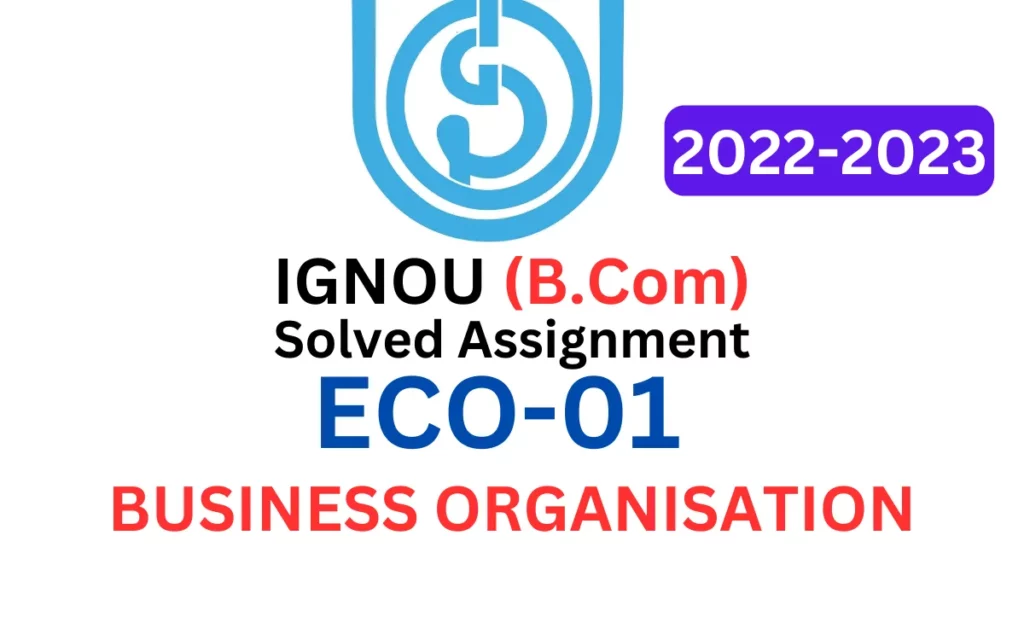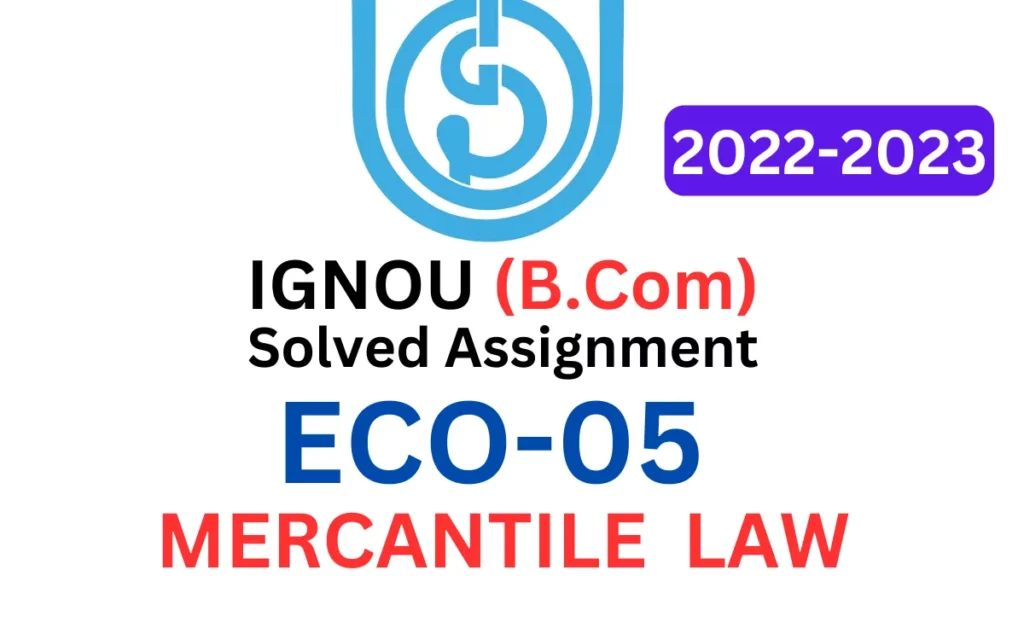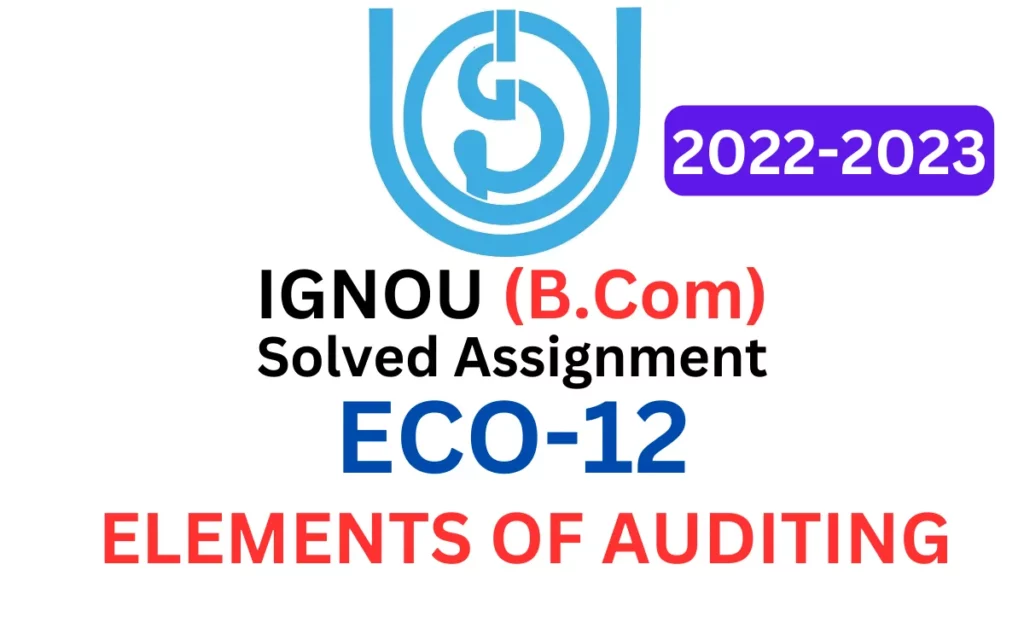Contents
- 1 Q.1 Discuss the institutions providing technical services for the promotion of export in India. Explain the institutional setup for Government policy making and consultation for export promotion in India.
- 2 Q.2 (a) Discuss the duties of an exporter under FOB and CIF contract. Describe the major legal implications of FOB contract.
- 3 (b) State the documents required for export. Discuss in detail the features of Commercial invoice and Bill of lading.
- 4 Q.3 Comment on the following:
- 5 (a) Standard policies of ECGC cover losses of all types of risks.
- 6 (b) Credit is a major weapon of international competition but it involves risk.
- 7 (c) Exporters and importers are not exposed to any exchange risks.
- 8 (d) The role of marketing effort is not crucial in export promotion.
- 9 Q.4 Differentiate between the following:
- 10 (a) Pre-shipment finance and Post-shipment finance
- 11 (b) Voyage charter and Time charter
- 12 (c) Trading house and Star trading house
- 13 (d) FOB contract and CIF contract
- 14 Q.5 Write a short note on the following:
- 15 (a) Forward Contracts
- 16 (b) India Trade Promotion Organization
- 17 (c) War Perils
- 18 (d) EXIM bank
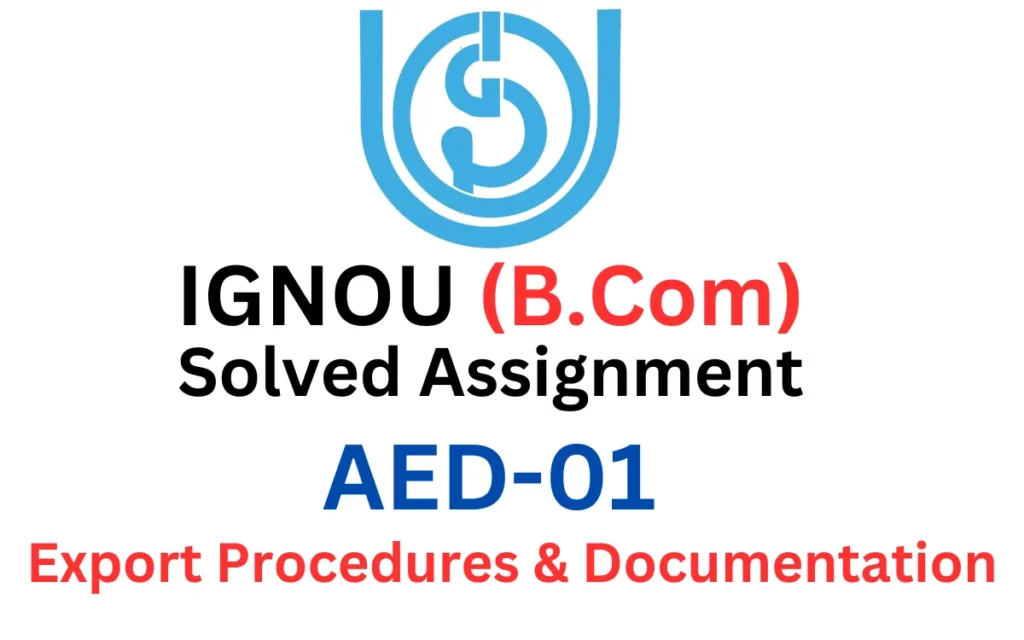
| Title | AED-01: IGNOU B.Com Solved Assignment 2022-2023 |
| University | IGNOU |
| Degree | Bachelor Degree Programme |
| Course Code | AED-01 |
| Course Name | Export Procedures & Documentation |
| Programme Name | B.Com |
| Programme Code | BDP |
| Total Marks | 100 |
| Year | 2022-2023 |
| Language | English |
| Assignment Code | AED-01/TMA/2022-23 |
| Assignment PDF | Click Here |
| Last Date for Submission of Assignment: | For June Examination: 31st April For December Examination: 30th September |
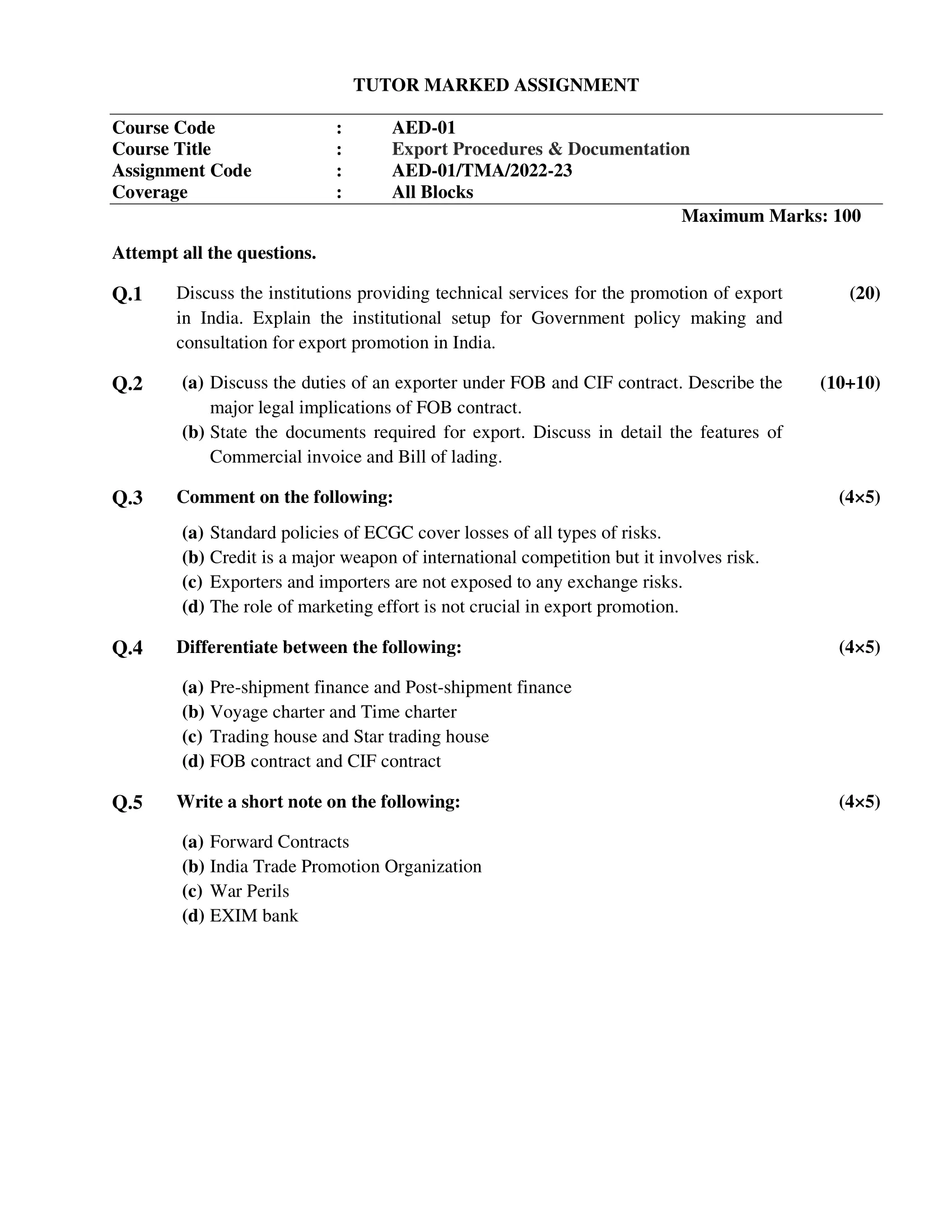
Q.1 Discuss the institutions providing technical services for the promotion of export in India. Explain the institutional setup for Government policy making and consultation for export promotion in India.
Ans: India has a vast network of institutions that provide technical services for the promotion of exports. These institutions play a crucial role in facilitating trade and enhancing the competitiveness of Indian goods in the global market. Some of the prominent institutions providing technical services for export promotion in India are:
- Export Promotion Councils (EPCs): EPCs are set up by the Government of India to promote exports of specific products from India. There are currently 14 EPCs operating in India, covering products ranging from textiles to engineering goods. These councils provide technical assistance to exporters, organize trade fairs and exhibitions, and facilitate market access for Indian products.
- Indian Institute of Foreign Trade (IIFT): IIFT is a premier institution for international business education and research in India. It also provides technical services to exporters in the form of training, research, and consultancy services. IIFT also works closely with various government agencies to promote India’s exports.
- Federation of Indian Export Organizations (FIEO): FIEO is a non-profit organization representing the Indian export community. It provides technical assistance to exporters, promotes exports through trade delegations and exhibitions, and advocates for the interests of Indian exporters with the government.
- Directorate General of Foreign Trade (DGFT): DGFT is the nodal agency responsible for implementing the Foreign Trade Policy of India. It provides technical assistance to exporters on various aspects of foreign trade, including import-export regulations, customs procedures, and trade-related documentation. NID is a premier institution for design education and research in India. It provides technical assistance to exporters in the form of design and product development services, which can help Indian exporters enhance the quality and competitiveness of their products in the global market.
The institutional setup for government policy-making and consultation for export promotion in India is primarily led by the Ministry of Commerce and Industry. The Ministry is responsible for formulating and implementing policies related to India’s international trade, including export promotion. The Ministry works closely with various other government agencies, including the DGFT, EPCs, and FIEO, to promote India’s exports.
The Ministry of Commerce and Industry also sets up various committees and task forces to provide advice and guidance on export promotion. For example, the Foreign Trade Policy (FTP) is formulated by a committee comprising representatives from various government agencies, industry associations, and other stakeholders. The FTP sets out the government’s strategy for promoting exports over a five-year period.
Q.2 (a) Discuss the duties of an exporter under FOB and CIF contract. Describe the major legal implications of FOB contract.
Ans: (a) Duties of an exporter under FOB and CIF contract:
FOB (Free on Board) and CIF (Cost, Insurance, and Freight) are two common international trade terms that define the responsibilities and obligations of exporters and importers in a contract. The duties of an exporter under FOB and CIF contract are as follows:
- FOB contract: Under an FOB contract, the exporter’s main duties include:
- Delivering the goods to the port of shipment and loading them onto the vessel nominated by the buyer
- Obtaining all necessary export licenses and permits
- Providing the buyer with the necessary shipping documents, such as the bill of lading and commercial invoice
- Clearing the goods for export and paying all export-related costs up to the point of delivery on board the vessel
- CIF contract: Under a CIF contract, the exporter’s main duties include:
- Delivering the goods to the port of shipment and loading them onto the vessel nominated by the buyer
- Obtaining all necessary export licenses and permits
- Arranging for marine insurance coverage for the goods
- Providing the buyer with the necessary shipping documents, such as the bill of lading and commercial invoice
- Clearing the goods for export and paying all export-related costs up to the point of delivery on board the vessel
In both FOB and CIF contracts, the exporter is responsible for ensuring that the goods are delivered to the port of shipment and loaded onto the vessel in good condition. The exporter is also responsible for providing the necessary shipping documents to the buyer and for paying all export-related costs up to the point of delivery on board the vessel.
(b) Major legal implications of FOB contract:
FOB contracts have several legal implications that exporters should be aware of. Some of the major legal implications of an FOB contract are:
- Transfer of title and risk: Under an FOB contract, the title and risk in the goods transfer from the seller to the buyer when the goods are loaded onto the vessel nominated by the buyer. This means that the seller’s responsibility ends once the goods are loaded onto the vessel, and the buyer becomes responsible for any damage or loss of the goods during transit.
- Payment terms: FOB contracts typically require payment to be made by the buyer upon presentation of the shipping documents, such as the bill of lading and commercial invoice. This means that the exporter must ensure that the shipping documents are in order and that the goods are loaded onto the vessel before payment is made.
- Shipping documentation: Under an FOB contract, the exporter is responsible for providing the necessary shipping documents to the buyer. These documents include the bill of lading, commercial invoice, and packing list. The exporter must ensure that these documents are accurate and complete, as any errors or omissions can delay the release of the goods at the destination port.
- Incoterms rules: FOB contracts are subject to the International Chamber of Commerce’s Incoterms rules, which define the rights and obligations of the buyer and seller in a contract. It is important for exporters to understand and comply with these rules to avoid any disputes or legal issues.
(b) State the documents required for export. Discuss in detail the features of Commercial invoice and Bill of lading.
Ans: Export documentation is a crucial aspect of international trade, and exporters need to prepare and submit several documents to comply with the regulations and requirements of the importing country. The documents required for export may vary depending on the destination country, product, and mode of transportation. However, some of the common documents required for export include:
- Commercial invoice
- Bill of lading
- Packing list
- Certificate of origin
- Export license
- Inspection certificate
- Insurance certificate
- Consular invoice
- Pro forma invoice
- Shipping instruction
In this answer, we will discuss the features of two essential export documents: the commercial invoice and the bill of lading.
Features of Commercial Invoice:
A commercial invoice is a document that provides details of the goods sold by the exporter to the importer. It is a critical document used for customs clearance and serves as proof of sale and value for taxation purposes. Some of the key features of a commercial invoice are:
- Description of goods: The commercial invoice must contain a detailed description of the goods, including the quantity, unit price, total value, and any other relevant information.
- Names and addresses: The invoice must include the names and addresses of the exporter and importer, as well as any intermediaries involved in the transaction.
- Payment terms: The invoice must specify the payment terms agreed between the exporter and importer, including the currency, method of payment, and any other relevant details.
- Shipping details: The invoice must include the mode of transportation, shipment date, and destination port, as well as any other relevant shipping details.
- Incoterms: The invoice must specify the Incoterms used in the transaction, which define the responsibilities and obligations of the exporter and importer.
Features of Bill of Lading:
A bill of lading is a document that serves as a receipt for the goods shipped and evidence of the contract of carriage between the exporter and the carrier. It is an essential document for the exporter, importer, and carrier, and serves as proof of ownership and title to the goods. Some of the key features of a bill of lading are:
- Parties involved: The bill of lading must include the names and addresses of the exporter, importer, and carrier, as well as any intermediaries involved in the transaction.
- Description of goods: The bill of lading must contain a detailed description of the goods, including the quantity, weight, and any other relevant information.
- Shipment details: The bill of lading must specify the mode of transportation, shipment date, and destination port, as well as any other relevant shipping details.
- Freight charges: The bill of lading must include the freight charges agreed between the exporter and carrier, as well as any other relevant charges.
- Signature: The bill of lading must be signed by the carrier or its agent, indicating acceptance of the goods for carriage.
Q.3 Comment on the following:
(a) Standard policies of ECGC cover losses of all types of risks.
Ans: The statement is not entirely accurate. While it is true that the Export Credit Guarantee Corporation (ECGC) provides insurance policies that cover various risks, it is not accurate to say that their standard policies cover losses of all types of risks.
ECGC provides insurance coverage for commercial and political risks associated with exports, but the extent of coverage may vary depending on the specific policy and the circumstances of the loss. Some risks that ECGC policies typically cover include default by foreign buyers, insolvency of the buyer or importer, and political risks such as war or changes in government policy. However, there may be certain types of risks that are not covered by ECGC policies, such as force majeure events or losses due to natural disasters.
It is also important to note that ECGC offers different types of policies with varying levels of coverage. For example, ECGC’s standard policies may provide coverage up to a certain percentage of the value of the goods exported, while their specific policies may provide coverage for a higher percentage or cover additional risks. Therefore, it is important for exporters to carefully review their insurance options and policies to ensure that they have adequate coverage for the specific risks they may face.
(b) Credit is a major weapon of international competition but it involves risk.
Ans: The statement is generally true. Credit can be a powerful tool for companies engaging in international competition as it enables them to offer attractive payment terms to customers and gain a competitive advantage in the market. However, extending credit also involves risks, particularly in cross-border transactions where there may be a lack of familiarity with the customer, legal system, or political climate of the buyer’s country.
There are several risks associated with international credit transactions, including the risk of default by the buyer, currency risk, political risk, and legal risk. Default risk refers to the risk that the buyer may not be able to pay for the goods or services purchased, which can result in significant financial losses for the exporter. Currency risk arises from fluctuations in exchange rates, which can affect the value of payments received by the exporter. Political risk refers to the risk of changes in government policies, regulations, or instability in the buyer’s country that could impact the transaction. Legal risk relates to the risk of disputes or legal actions arising from the transaction.
To manage these risks, companies engaging in international credit transactions may use a variety of tools and strategies, such as credit insurance, letters of credit, or factoring. Credit insurance can provide protection against non-payment, while letters of credit provide a secure method of payment. Factoring involves selling receivables to a third party at a discount, which can provide immediate cash flow and transfer the risk of non-payment to the factor.
(c) Exporters and importers are not exposed to any exchange risks.
Ans: The statement is not accurate. Exporters and importers are typically exposed to exchange rate risks, particularly when engaging in cross-border transactions that involve different currencies.
Exchange rate risk refers to the risk of loss that arises from changes in exchange rates between the time a transaction is initiated and the time it is settled. For exporters, exchange rate risk arises when they receive payments in a foreign currency that must be converted back into their domestic currency. If the exchange rate between the two currencies changes unfavorably, the exporter may receive fewer units of their domestic currency than they had anticipated, resulting in a loss.
Similarly, importers are also exposed to exchange rate risk when they purchase goods or services in a foreign currency that must be converted back into their domestic currency. If the exchange rate changes unfavorably, the importer may have to pay more in their domestic currency than they had anticipated, resulting in a higher cost of goods.
To manage exchange rate risk, exporters and importers may use a variety of tools and strategies, such as forward contracts, options, or currency hedging. For example, forward contracts allow exporters and importers to lock in a specific exchange rate for a future date, while currency hedging involves using financial instruments to offset the impact of exchange rate fluctuations.
(d) The role of marketing effort is not crucial in export promotion.
Ans: The statement is not accurate. Marketing efforts play a crucial role in export promotion, as they help companies to identify and capitalize on opportunities in foreign markets and promote their products or services effectively to potential customers.
Export promotion involves a range of activities designed to increase the international competitiveness of a country’s goods or services, such as identifying new export markets, providing financial or technical assistance to exporters, and promoting the country’s exports to foreign buyers. Marketing efforts are an essential component of this process, as they enable companies to:
- Identify and understand the needs and preferences of potential customers in foreign markets
- Develop marketing strategies that effectively communicate the value proposition of their products or services to these customers
- Establish a strong brand presence in foreign markets that differentiates them from competitors
- Cultivate relationships with foreign buyers and distribution partners that help to build trust and facilitate business transactions
Effective marketing efforts can also help companies to overcome barriers to entry in foreign markets, such as language or cultural differences, and navigate complex regulatory environments.
Q.4 Differentiate between the following:
(a) Pre-shipment finance and Post-shipment finance
Ans: Pre-shipment finance and post-shipment finance are two types of trade finance used to finance the various stages of the export process. The main differences between the two are as follows:
- Definition: Pre-shipment finance refers to the credit facilities provided to the exporter before the shipment of goods, while post-shipment finance is the credit facilities provided to the exporter after the shipment of goods.
- Purpose: Pre-shipment finance is used to finance the production and processing of goods, packaging, and transportation to the port of shipment. Post-shipment finance, on the other hand, is used to finance the working capital requirements of the exporter after the shipment of goods, such as the payment of salaries, raw materials, and other operating expenses.
- Repayment: Pre-shipment finance is usually repaid once the exporter receives payment from the importer, while post-shipment finance is repaid within a specific period, usually 30-90 days after the shipment of goods.
- Security: Pre-shipment finance is usually secured by the goods or the export order, while post-shipment finance is secured by the export documents, such as the bill of lading, invoice, and insurance policy.
- Interest rates: The interest rates for pre-shipment finance are generally lower than those for post-shipment finance, as pre-shipment finance is considered less risky than post-shipment finance.
(b) Voyage charter and Time charter
Ans: Voyage charter and time charter are two types of charter parties used in the shipping industry to hire a vessel for the transportation of goods. The main differences between the two are as follows:
- Definition: A voyage charter is a contract where the shipowner agrees to transport a specific cargo from one port to another for a single voyage, while a time charter is a contract where the shipowner agrees to provide the use of the vessel for a specific period, during which the charterer can use the vessel to transport goods.
- Duration: A voyage charter is for a single trip, while a time charter is for a specific period, usually ranging from several months to several years.
- Freight: In a voyage charter, the freight is usually paid on a lump-sum basis or per metric ton of cargo, while in a time charter, the freight is usually paid on a daily or monthly basis.
- Responsibility: In a voyage charter, the shipowner is responsible for the vessel’s operation and maintenance during the voyage, while in a time charter, the charterer is responsible for the vessel’s operation and maintenance during the charter period.
- Control: In a voyage charter, the shipowner has control over the vessel’s route and schedule, while in a time charter, the charterer has more control over the vessel’s route and schedule.
- Expenses: In a voyage charter, the shipowner is responsible for all expenses related to the vessel’s operation during the voyage, including fuel, port charges, and crew costs. In a time charter, the charterer is responsible for the vessel’s operating expenses, such as fuel, port charges, and crew costs, while the shipowner is responsible for the vessel’s capital expenses, such as maintenance and repairs.
(c) Trading house and Star trading house
Ans: Trading house and star trading house are two types of export promotion schemes in India. The main differences between the two are as follows:
- Definition: A trading house is a company that is engaged in the export of goods and services, while a star trading house is a trading house that has demonstrated a sustained growth in exports and has a significant share of the country’s total exports.
- Eligibility: To be eligible for a trading house status, a company needs to have a minimum export turnover of Rs. 5 crore in the previous year, while to be eligible for a star trading house status, a company needs to have a minimum export turnover of Rs. 25 crore in the previous year.
- Benefits: A trading house is eligible for various benefits, such as the issuance of export-import licenses, duty-free imports of capital goods, and access to export promotion capital goods (EPCG) scheme. A star trading house, on the other hand, is eligible for additional benefits, such as priority in the allocation of export orders and access to specialized services from export promotion councils.
- Validity: The status of a trading house and a star trading house is valid for three years, after which the company needs to reapply for the status.
(d) FOB contract and CIF contract
Ans: FOB (Free On Board) and CIF (Cost, Insurance, and Freight) are two commonly used international trade terms that describe the responsibility and liability of the buyer and seller in a sales transaction.
- Definition: FOB contract is a contract where the seller is responsible for delivering the goods to the port of shipment and loading them onto the shipping vessel. The buyer is responsible for the transportation of the goods from the port of shipment to the destination and bears the risk of loss or damage during transit. CIF contract, on the other hand, is a contract where the seller is responsible for delivering the goods to the port of destination, including the cost of insurance and freight. The buyer is responsible for the payment of the goods, the cost of unloading the goods at the destination port, and any applicable customs duties or taxes.
- Cost and liability: Under FOB contract, the cost and liability of the goods transfer from the seller to the buyer once the goods are loaded onto the shipping vessel. The buyer is responsible for any loss or damage to the goods during transit, including any customs duties or taxes. Under CIF contract, the seller is responsible for the cost of insurance and freight, and the risk of loss or damage to the goods until they reach the destination port. Once the goods are unloaded from the vessel, the buyer is responsible for any loss or damage to the goods, including any customs duties or taxes.
- Insurance: Under FOB contract, the buyer is responsible for arranging insurance for the goods during transit, while under CIF contract, the seller is responsible for arranging insurance for the goods.
- Control: Under FOB contract, the buyer has more control over the shipping process, including the choice of shipping company and the timing of the shipment. Under CIF contract, the seller has more control over the shipping process, including the choice of shipping company and the timing of the shipment.
Q.5 Write a short note on the following:
(a) Forward Contracts
Ans: A forward contract is a type of financial instrument that allows two parties to agree to buy or sell an asset, such as a currency, commodity, or stock, at a predetermined price and future date. Forward contracts are often used to manage the risk of price fluctuations in an asset, particularly in international trade where the value of currencies can change rapidly.
In a forward contract, the buyer agrees to purchase the asset at a specified future date, while the seller agrees to deliver the asset at the same future date. The price at which the asset will be bought or sold is agreed upon at the time the contract is made. This allows both parties to hedge against the risk of future price changes in the asset.
Forward contracts are commonly used by companies engaged in international trade to manage foreign exchange risk. For example, an exporter who expects to receive payment in a foreign currency in the future may use a forward contract to lock in the exchange rate at which the payment will be converted back into their domestic currency. This can provide certainty and protection against adverse exchange rate movements that could erode the value of the payment.
However, forward contracts are not without risk. If the actual price of the asset at the time of settlement is different from the agreed-upon price, one party will realize a profit while the other will incur a loss. Additionally, forward contracts are typically not traded on exchanges and are therefore less standardized and less liquid than other financial instruments, which can make them more difficult to value and trade.
(b) India Trade Promotion Organization
Ans: India Trade Promotion Organization (ITPO) is a government-owned organization that operates under the Ministry of Commerce and Industry in India. ITPO is responsible for promoting and facilitating India’s trade with other countries by organizing trade fairs, exhibitions, and other promotional events.
ITPO was established in 1977 with the goal of promoting India’s exports and encouraging foreign investment in the country. Its main objectives are to:
- Provide a platform for Indian exporters to showcase their products and services to international buyers
- Attract foreign buyers and investors to India by highlighting the country’s business opportunities and investment potential
- Promote the Indian brand and image internationally by showcasing India’s cultural heritage, traditions, and modern achievements
To achieve these objectives, ITPO organizes various trade promotion events throughout the year, including international trade fairs, exhibitions, and buyer-seller meets. These events provide a platform for Indian exporters to interact with foreign buyers and showcase their products and services. ITPO also provides various services to Indian exporters, such as market intelligence, business matching, and logistical support.
In addition to promoting India’s exports, ITPO also helps foreign companies to invest in India by providing information on investment opportunities, regulatory requirements, and other aspects of doing business in the country. It also works closely with other government agencies and trade associations to promote India’s interests and facilitate trade and investment flows.
(c) War Perils
Ans: War perils refer to the risks and damages associated with war or any other form of armed conflict. These risks can include damage to property, loss of life, disruption of business activities, and other adverse effects.
In international trade, war perils can have a significant impact on the movement of goods and services between countries. War or conflict in a region can lead to disruptions in transportation and communication systems, which can affect the delivery of goods and services. It can also lead to increased costs, as insurance premiums and other expenses related to risk management may rise.
To mitigate the risks associated with war perils, companies engaged in international trade often purchase insurance policies that cover these risks. Such policies typically cover loss or damage to cargo caused by acts of war, riots, civil unrest, and other similar events.
In addition to insurance, companies may also take other steps to manage their exposure to war perils, such as diversifying their supply chains to reduce their reliance on any one region, investing in risk management and contingency planning, and closely monitoring geopolitical developments and conflict zones.
(d) EXIM bank
Ans: EXIM Bank stands for Export-Import Bank of India, which is a government-owned financial institution that operates under the Ministry of Finance in India. The bank was established in 1982 with the goal of promoting India’s international trade by providing financial assistance and support to Indian exporters and importers.
EXIM Bank provides a range of financial products and services to support international trade, including export credit, buyer’s credit, project exports, lines of credit, and export credit insurance. These products and services are designed to help Indian exporters and importers to expand their business overseas and mitigate the financial risks associated with international trade.
EXIM Bank also plays a critical role in supporting India’s economic development and growth by financing infrastructure projects in various sectors, including energy, transportation, telecommunications, and healthcare. The bank provides loans and guarantees to both Indian and foreign entities involved in these projects, which helps to create jobs and promote economic growth in India and abroad.
In addition to its financial activities, EXIM Bank also provides research and advisory services to support Indian businesses engaged in international trade. It publishes reports and studies on various aspects of international trade and provides guidance and advice to Indian companies on how to expand their business overseas.
How to Download AED-01 Solved Assignment?
You can download it from the www.edukar.in, they have a big database for all the IGNOU solved assignments.
Is the AED-01 Solved Assignment Free?
Yes this is absolutely free to download the solved assignment from www.edukar.in
What is the last submission date for AED-01 Solved Assignment?
For June Examination: 31st April, For December Examination: 30th October



